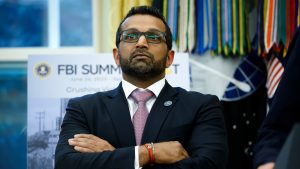As more patients turn to medical marijuana, doctors and lawmakers remain divided

ST. LOUIS — After trying 36 different medications with no relief, Josh Dunifon felt he was out of options. A cabinet once filled with prescriptions now symbolized years of failed treatments for the severe back pain he’d endured following a major truck accident seven years ago.
“I started getting really desperate,” Dunifon told Straight Arrow News. “When the traditional stuff from the pharmacies didn’t work, I had to figure something out.”
Dunifon, 48, had long opposed marijuana use. But he reconsidered after his doctor suggested medical cannabis.
“It never crossed my mind,” he told SAN. “I’d never done it as a teenager, I was against it. I really didn’t like the sound of it, but I was so desperate — I would’ve licked a toad if it would have helped me.”
Under the care of Dr. Patricia Hurford, a specialist in physical medicine and rehabilitation, Dunifon began taking low-dose cannabis gummies. The results were slow but were felt immediately.
“I was completely sober — only I just had about 50% less pain,” he said.
Doctors still cautious
Dunifon is one of roughly 3.7 million medical marijuana patients in the U.S., according to the Medical Marijuana Project. However, despite growing use, many physicians remain hesitant to recommend cannabis.
“Only about 30% of physicians feel comfortable discussing cannabis,” said Hurford. “That 30% doesn’t include those who have a more intimate knowledge of cannabis’ therapeutic potential.”
Hurford points to marijuana’s federal classification as a major barrier. The drug remains a Schedule I substance — the same category as heroin and methamphetamine — meaning it is officially considered to have “no currently accepted medical use and a high potential for abuse,” according to the U.S. Drug Enforcement Administration.
“It’s more dangerous than cocaine, oxycodone or fentanyl, according to current scheduling,” Hurford told SAN. “By placing it in a lower classification, I think it takes a bit of that stigma away — not just for patients, but for physicians too.”
Unbiased. Straight Facts.TM
Schedule I drugs are defined as drugs with no currently accepted medical use and a high potential for abuse, with examples including heroin, LSD, ecstasy and peyote.

A divided debate
But the final product is sold at dispensaries, rather than pharmacies.
That distinction concerns Jordan Davidson, government affairs director for Smart Approaches to Marijuana. SMART is a nonprofit organization that opposes the legalization and commercialization of non-medical marijuana.
“There’s no other medication where a doctor gives you a card that lets you get an unlimited prescription of an intoxicating substance at a commercial retail operation,” Davidson told SAN. “It’s not being handled by trained medical professionals or pharmacists.”
Davidson’s organization advocates for science-based cannabis policies and opposes full legalization and commercialization.
“There’s no reason we can’t reform within the system and loosen research restrictions without rescheduling the drug,” Davidson said. “Rescheduling is the first step toward addiction-for-profit.”
Shifting legal and political landscape
In August, President Donald Trump announced his administration was reviewing marijuana’s federal classification.
“Some people like it, some people hate it,” Trump said at a press conference. “But we’re looking at reclassification and will make a determination over the next few weeks.”
Legislation is also in motion. Rep. Jerrold Nadler, D-N.Y., reintroduced the Marijuana Opportunity Reinvestment and Expungement (MORE) Act, which seeks to decriminalize cannabis federally. The act would remove marijuana from the Controlled Substances Act and eliminate federal criminal penalties for its manufacture, distribution or possession. The bill is currently before the House Judiciary Committee.
So far, 24 states and Washington, D.C., have legalized adult-use marijuana. Forty states allow medical cannabis.
Research and recovery
Europe has become a leader in cannabis research. Just last month, clinical trials in Germany showed the drug as a replacement for opioids when treating back pain. The U.S. could be years away from clinical trials as the FDA currently limits research on Schedule 1 drugs.
Dunifon, who lives in Missouri, where cannabis is legal for both medical and recreational use, said it took a year to notice significant improvements.
“I couldn’t lift my left arm above my shoulder,” he said. “Now I have full range of motion in both arms — but that’s from medicating and then being able to survive the exercises to get your range of motion.”
He credits medical marijuana with helping him regain strength and return to work. He said it also changed his mindset.
“I’m not here to say this is right for everybody,” Dunifon said. “But if you’re responsible and use it responsibly, you can get really great results.”
The post As more patients turn to medical marijuana, doctors and lawmakers remain divided appeared first on Straight Arrow News.





